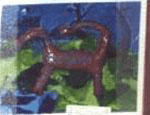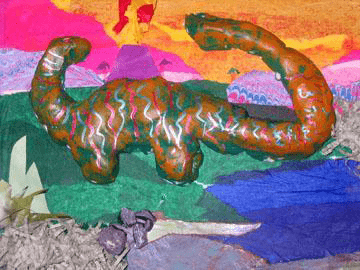Goal (Terminal Objective):
Sculpture/ Collage
Objective:
Students will become aware of processes, techniques, and media variety used in art forms to communicate ideas. Students will perceive how technique, balance, and texture function in a work of art. Students will be able to identify characteristics of sculptural art forms. Students will analyze sculpture to better understand techniques utilized in specific works of art.
National Standards:
Visual Arts Grades 58 Content Standard 1: Understanding and applying media, techniques, and processes
Visual Arts Grades 58 Content Standard 2: Using knowledge of structures and functions
Visual Arts Grades 58 Content Standard 3: Choosing and evaluating a range of subject matter,symbols, and ideas
Purpose:
Students will identify characteristics of prehistoric life and dinosaurs. Students will respond to a variety of sculptural art forms. Students will identify relief sculpture as an art form. Students will identify characteristics of relief and free standing sculpture created in a variety of media. Students will execute a relief sculpture using basic forms and place it in a related environment.
New Vocabulary:
landscape, distance, perspective, horizon line, background, middle ground, foreground, depth, 2d plane, texture, simulate, relief, free standing, sculpture, basic forms, fossil, imprint, medium, paleontologist, archeologist
Materials:
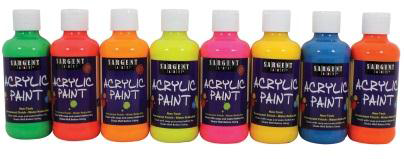
#22-22xx Fluorescent Acrylic Paint
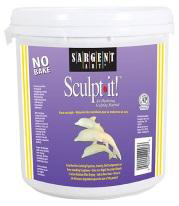
#22-2003 Sculpt-It! White Re-sealable Tub
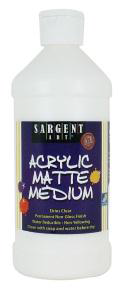
#22-8815 Acrylic Matte Medium

#22-1103 Craft Glue
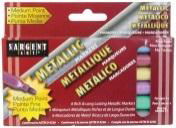
#22-1506 Metallic Medium Point Peggable Carton Markers
Clay tools, illustration board or cardboard, tissue paper scraps, natural fibers or grasses, brushes
Time:
This lesson may be modified from one to five hours, depending upon the size and complexity of expectations.
Introduction and Motivation (Set):
Review and broaden students’ knowledge of sculpture. Compare the difference between two dimensional shapes and three dimensional forms.Identify basic forms used in sculpture. Discuss the variety of materials used by artists to make sculptural forms. Discuss students’ prior knowledge in viewing and creating three dimensional art forms.
View pictures of dinosaurs. Discuss the variety of main shapes that compose a dinosaur’s body.
View the prehistoric landscapes, discuss how artists show depth on a twodimensional plane, i.e., placement and size of objects. Introduce/Review vocabulary terms.
Discuss how artists often make sketches by drawing main shapes and lines before drawing details. Describe how artists use light lines to first draw their main shapes, then other shapes and lines are gradually added.
Instruction:
Teacher provides additional fine art exemplars for analyzation. Read stories about dinosaurs.
Students view photos and/or videos of prehistoric environments and dinosaurs list characteristics.
Teacher leads in demonstration and/or presentation reviewing steps to sketch a dinosaur using basic forms. Teacher demonstrates modeling relief dinosaur referring to planning sketch.
Teacher discusses dinosaur environmental landscapes, identifies areas to locate horizon line and background detail such as mountains and volcano.
Activities:
(1) GuidedPractice:
- Students make lists of what objects will be in their prehistoric landscapes. Students create sketches for their prehistoric landscapes.
- Students use tissue paper scraps and glue mixed with water to create sky background and land background.
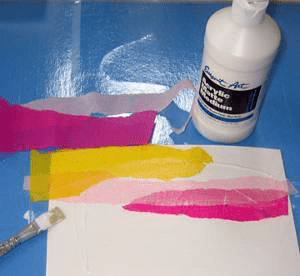
- Students make lists of what characteristics their dinosaur will have. What kind of teeth will it have, how will it move (on two feet or four feet). Students create sketches for their dinosaur.
- Students cut out selected dinosaurs and apply Sculptit to each dinosaur building up forms in relief.
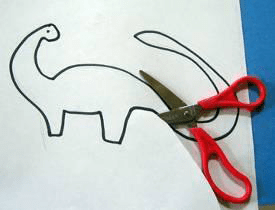
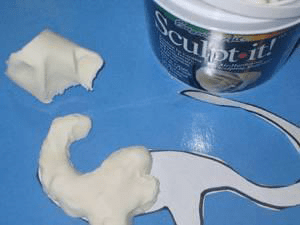
Students will complete the following steps:
- Using clay tools, simulate scale texture in the dinosaur’s body. Additional lines and textures can be created to give the character.
- Use Sargent tempera to paint a base coat on the dinosaur.
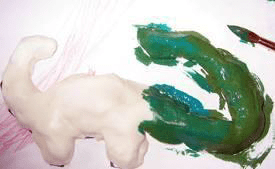
- Additional colors may be added for interest. Liquid Metal markers may be used.
- Glue dinosaur to tissue collage prehistoric landscape.

(2) Independent Practice and Check for Understanding: Teacher circulates among working students visually recording students demonstrating understanding of objectives and provides reinforcement. Teacher will assist students in focusing on the idea of drawing main shapes and main structural lines of objects.
(3) Closure: Students record, either by checklist or writing prompt, the symbols used, the connection to the exemplar and the innovations they provided to their composition. Review new vocabulary.
Evaluation:
Teacher/student critique and/or individual evaluation: Describe what forms were used to create dinosaur. Describe how depth was created in the prehistoric landscape. Analyze why certain materials were used in creation of this work ofart.
Extension: This strategy may be extended to providing collage items in the lower part of the composition such as grasses, dinosaur eggs, other animals, or vegetation.
Have students write a story about what their dinosaur will do.
Divide the class into groups of four to six students. Have each group make a short play using the dinosaurs as characters.
Have students write a short paragraph about why they chose certain features for their dinosaurs and how those features will help the dinosaurs live.
Have students pretend they are paleontologists. Ask them to write a short story about something they have found, how they felt, and what happened after the discovery.
Resources:
http://en.wikipedia.org/wiki/Dinosaur
http://www.search4dinosaurs.com/
http://www.bbc.co.uk/sn/prehistoric_life/
http://www.nps.gov/dino/
http://www.ucmp.berkeley.edu/diapsids/dinosaur.html
Art Consultant



